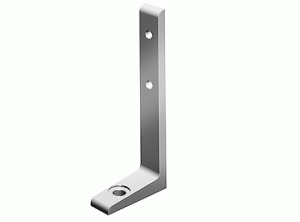
If you’re looking to install a partitioning wall, aluminum frame or other tall objects in your workplace, you may want to use floor brackets. They offer a simple and effective anchoring point for vertical structures.
What Are Floor Brackets?
Floor brackets are L-shaped supporting brackets that are designed for use on the floor. Like other L-shaped brackets, they feature a short arm and a long arm. Floor brackets, however, are designed specifically for use on the floor. You can mount them on the floor, after which you can connect vertical structures to them.
How to Use Floor Brackets
You can use floor brackets by mounting them on the floor and to the vertical structures that you want to support with a set of threaded fasteners. A typical floor bracket features several threaded holes. The short arm, for instance, may have one threaded hole, whereas the long arm may have two or more threaded holes.
Installing a floor bracket involves driving bolts through these threaded holes and into the floor and vertical structure. After positioning the vertical structure — partitioning wall, aluminum panel, etc. — on the floor, place the floor bracket against the side of it. The floor bracket should be sitting on top of the floor while also resting against the side of the vertical structure. You can then drive a set of bolts through the floor bracket’s holes so that it stays in place.
Common Features of Floor Brackets
Aluminum is a common material from which floor brackets are made. Aluminum floor brackets are strong, durable and resistant to corrosion. They also cost less than floor brackets made of many other materials, such as steel.
You can find floor brackets in different sizes. Some of them have longer arms than others. Floor brackets, of course, feature two arms, one of which is shorter than the other. But the specific length of a floor bracket’s short and long arms may vary. If you’re planning to buy floor brackets, you should consider the length of its arms.
In Conclusion
Brackets are available in different styles. While many of them feature an L-shaped design, some of them are designed specifically for use on the floor. Known as floor brackets, you can use them to secure vertical structures in place. Floor brackets will hold the vertical structures with which they are used upright so that they don’t fall over or otherwise move.
